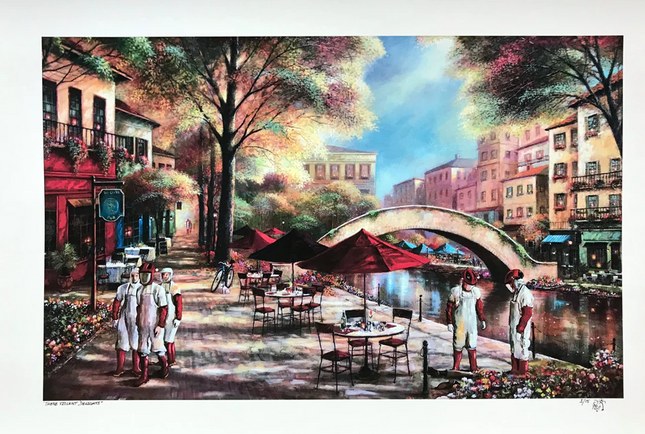
Business Jobs & Work
-

Dave Pollot These Violent Delights Giclee Print by Dave Pollot
These Violent Delights Giclee Print by Dave Pollot Artwork Limited Edition Print on Fine Art Paper Graffiti Pop Street Artist. 2020 Signed & Numbered Limited Edition of 15 Artwork Size 24x16.5 Vinatge Italian City on Riverway Populated By Workers From Westworld TV Show Dave Pollot's "Old Is New Is Old Again" is a compelling piece of limited edition giclee print artwork that has found its grounding in the intersection of pop art, street art, and graffiti art. Released in 2020, this stunning piece is a testament to Pollot's unparalleled ability to repurpose, reimagine, and recontextualize traditional art forms into contemporary and engaging works. As part of an exclusive series, only 10 signed and numbered copies of this masterpiece exist, each meticulously produced on fine art paper to ensure longevity and vibrancy of color. Measuring 8x10 inches, with a mat that extends the dimensions to 11x14 inches, "Old Is New Is Old Again" is a captivating representation of a Renaissance man in vintage attire. The main subject, distinguished and posed as a gentleman of a bygone era, sports a curious addition that beautifully exemplifies Pollot's creative aesthetic — a graphic of a wolf howling at the moon. This piece seamlessly integrates aspects of modern imagery with classical portraiture, resulting in a unique fusion that embodies the spirit of graffiti pop and street art. In the realm of pop art, Pollot's piece is a nod to the repetition and mass production synonymous with the movement. By embedding modern iconography into a traditional portrait, the artist creatively merges past and present, thereby urging viewers to explore the ubiquitous influence of pop culture on societal perception. The wolf, a symbol often found in street and graffiti art, adds an element of rawness and organic spirit to the otherwise refined and polished depiction of the gentleman. Street art, often reflective of social and cultural expressions, finds its representation in the artwork as well. Pollot's rendering of the gentleman is symbolic of the adaptability and fluidity of street art, with its roots firmly set in the culture of the streets but its reach extending far beyond. The unorthodox incorporation of a graffiti-style wolf into a classical portrait suggests a strong link to street culture, bridging the gap between fine art and popular expressions of creativity. Graffiti art, traditionally associated with rebellion and counterculture, takes on a new form in "Old Is New Is Old Again." The howling wolf, often used in graffiti as a signifier of freedom and independence, has been seamlessly incorporated into the artwork. Its presence offers a stark contrast to the gentleman's attire, suggesting a dichotomy between societal norms and the desire for personal freedom and expression. Through this piece, Dave Pollot has remarkably bridged the gap between varying art forms and historical periods, crafting a timeless piece that speaks volumes of his understanding of art and culture. "Old Is New Is Old Again" is a perfect example of Pollot's ability to draw from diverse artistic movements and social themes, creating a work that resonates with the complexity and diversity of the human experience. In essence, this piece serves as a visual dialogue between different eras and artistic styles, proving that in the realm of art, the old and the new can coexist in the most harmonious and visually striking ways.
$493.00


